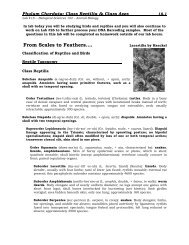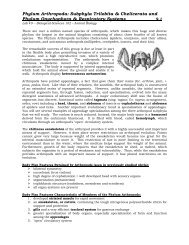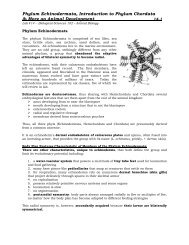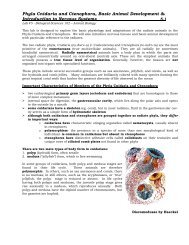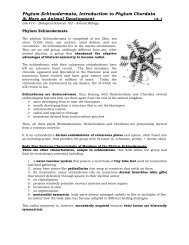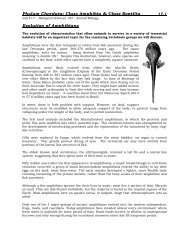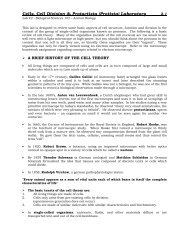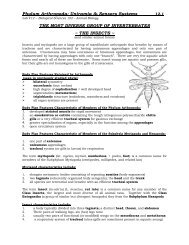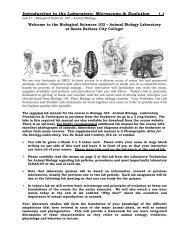Phyla Cnidaria and Ctenophora, Basic Animal Development ...
Phyla Cnidaria and Ctenophora, Basic Animal Development ...
Phyla Cnidaria and Ctenophora, Basic Animal Development ...
Create successful ePaper yourself
Turn your PDF publications into a flip-book with our unique Google optimized e-Paper software.
<strong>Phyla</strong> <strong>Cnidaria</strong> <strong>and</strong> <strong>Ctenophora</strong>, <strong>Basic</strong> <strong>Animal</strong> <strong>Development</strong> &<br />
Introduction to Nervous Systems 5.4<br />
Lab #5 - Biological Sciences 102 – <strong>Animal</strong> Biology<br />
In animals such as sponges <strong>and</strong> cnidarians, cleavage is irregular <strong>and</strong> seemingly disorganized;<br />
egg cytoplasm is partitioned r<strong>and</strong>omly into daughter cells of highly variable size <strong>and</strong> shape with<br />
no apparent relevance to future cell fates. As the metazoa evolved cleavage began to follow<br />
precise patterns <strong>and</strong> rhythms. In virtually all animal groups above the cnidarians, cleavage is<br />
regular; the egg cytoplasm is segregated into specific cells called blastomeres<br />
(Gr. blastos, bud, + meros, part) occupying discrete positions <strong>and</strong> having specific developmental<br />
fates.<br />
Patterns of regular cleavage depend greatly on amount <strong>and</strong> distribution of yolk in the egg. In<br />
eggs having a large amount of yolk, cleavage may be either complete (= holoblastic), as in<br />
amphibians, or incomplete (= meroblastic), as in birds <strong>and</strong> reptiles. In birds <strong>and</strong> reptiles with<br />
extreme telolecithal (Gr. telos, end, + lekithos, yolk) eggs, cleavage is restricted to a small disc<br />
of cytoplasm on the animal pole; this type of cleavage is called discoidal. The eggs of most<br />
insects follow another pattern of cleavage called superficial. In these the nuclei divide<br />
mitotically into hundreds or thous<strong>and</strong>s of "free" nuclei, which later migrate to the egg surface.<br />
Only then do cleavage furrows form, rapidly partitioning the cytoplasm into a superficial layer<br />
of cells.<br />
In most invertebrates, eggs have little yolk (= isolecithal ["equal-yolk"]), <strong>and</strong> cleavage is<br />
complete (holoblastic) <strong>and</strong> equal. Two major kinds of holoblastic cleavage exist: spiral <strong>and</strong><br />
radial (see text page 156, fig 8-7). The first two cleavages are the same in both kinds of eggs:<br />
the cleavage planes are along the animal-vegetal axis, producing a quartet of cells. At the third<br />
cleavage, however, these two patterns, spiral <strong>and</strong> radial, can be distinguished from each other<br />
by the geometric positioning of the cells.<br />
In radial cleavage, the third cleavage is perpendicular to the first two, yielding two quartets of<br />
cells, with the upper quartet lying directly on top of the lower. In spiral cleavage, the third<br />
cleavage planes are oblique to the polar axis <strong>and</strong> typically produce an upper quartet of smaller<br />
cells that come to lie between the furrows of the lower quartet of larger cells.<br />
There are other important differences between these two cleavage patterns. Spiral cleavage is<br />
typically mosaic, meaning that the embryo is constructed as a mosaic, with each cell fitting<br />
into its predetermined location in the larval body. If cells of the embryo are experimentally<br />
separated at this early stage, each cell will develop into partial or defective larvae because the<br />
developmental fate of each cell has already been determined. Spiral cleavage is found in<br />
several phyla, including annelids, many molluscs, some flatworms, <strong>and</strong> ribbon worms<br />
(nemerteans). All groups showing spiral cleavage belong to the grouping of animal phyla called<br />
the Protostomia, in which the embryonic blastopore forms the mouth.<br />
Early Embryonic <strong>Development</strong> - Cell Cleavages (mitosis)<br />
Radial cleavage is characteristically regulative<br />
because cell fate does not become fixed until after<br />
the first few cleavages. Radial cleavage is found in<br />
eggs of echinoderms <strong>and</strong> many chordates,<br />
especially protochordates, amphibians, <strong>and</strong><br />
mammals. (As mentioned earlier, eggs of birds <strong>and</strong><br />
reptiles, as well as many fishes, show discoidal<br />
cleavage.) All of these belong to the<br />
Deuterostomia, a group of phyla in which the<br />
mouth is formed from a secondary embryonic<br />
opening.



